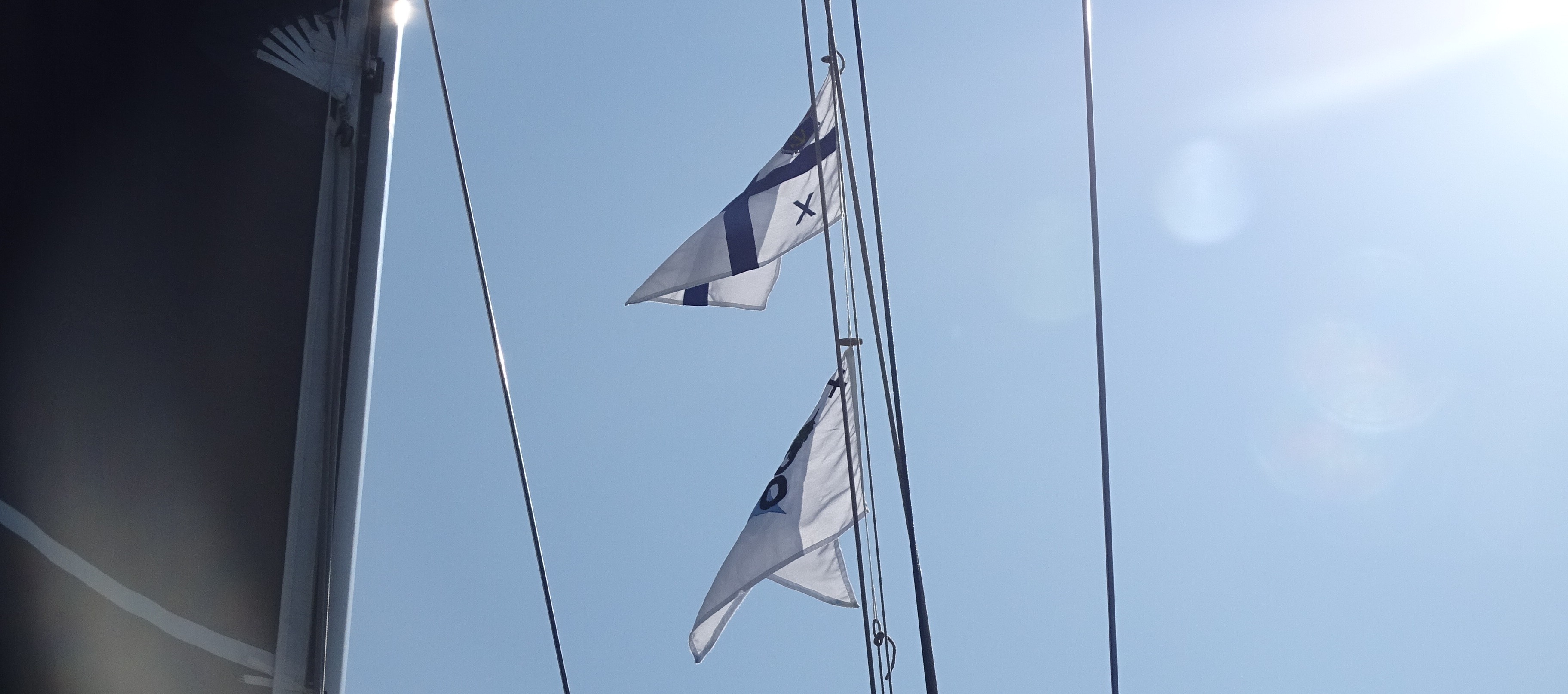We were lucky enough to book Lutine for the weekend at the end of Cowes Week, with Paul May as skipper and a crew of 8 Oxted Offshore members. Lutine was carrying her full racing sail wardrobe, so an exciting weekend beckoned, especially when a low developed off the Scottish coast on Friday and delivered lively winds all weekend! Peter Puttock takes up the story:

The Oxted Offshore Octet with skipper
HOW AN OXTED OFFSHORE OCTET BECAME VERY LUCKY SAILORS
starring
Paul May (Skipper) – nickname “The Boss”
Richard Aust (Chief Navigator) – Nickname “Vasco”
Kevin Ludbrook (First Mate) – Nickname “Action Man”
Belinda Martin (Crewlady) – Nickname “Flapjack Lil”
James Martin (Crewman) – Nickname “Scottie”
Peter Puttock (Photographer) – Nickname “Clean Loo Pete”
Lisa Quilter (Crewlady) – Nickname “Ginger Cake Girl”
John Taylor (Crewman) – Nickname “Tall John”
Fran Taylor (Crewlady) – Nickname “Topside Catering Girl”
It is not often that one gets the chance to sail on famous yachts, especially for a whole weekend. And so, when the opportunity to sail “Lutine” arose, a number of Oxted Offshore members immediately put their names forward, all trying not to appear to be indecently hasty about their acceptance. Paul May was to skipper Lutine for the weekend too, making it a true Oxted Offshore weekend.
55 foot of X-Yacht, complete with racing sails. Ours for the weekend! Christmas had come on 16 August 2019!
Lutine was going to be in Cowes, having competed in the Cowes Week Regatta. Her home port is Haslar in Gosport, so this was going to be a one-way trip. But how to get to Cowes?
It made sense to drive to Haslar (car sharing of course!) and leave our cars there for when we got back on Sunday. All we then had to do was get to Cowes … somehow. The “quickest” route was the Gosport Ferry (locally known as the Green Meanie, on account of their skippers’ attitude of taking no prisoners when it comes to rights of way within Porstmouth Harbour). Then walk to the Portsmouth – Ryde fast foot-passenger ferry. At Ryde we would trundle down the pier with all our kit and get a cab from town to Cowes Yacht Haven, where our quarry was waiting for us.
But no, not the Oxted Octet, we do things differently. That was too slow and too much trouble. So we booked ourselves a Rib to take us door to door (or pontoon to pontoon).

The crew of 8 convened at a blustery Haslar. Force 5 – 6 and rain were forecast so it was going to be a bumpy, but fun, ride. And it was – both bumpy and fun! And fast. Apparently, we hit 35 knots during our crossing to the Isle of Wight. What a way to arrive in Cowes – and just before the heavens opened!
After a few beers in the Pier Head and loading up the boat with a Waitrose delivery, we spent a lovely evening at Murrays. For those not familiar with Murrays, it was started about 20 years ago, specialises in fish, and is definitely aimed at the ravenous crew. After a very fulsome meal we retired to watch the end of Cowes week fireworks – in torrential rain! Luckily this was going to be the worst of the wet weather for the weekend.

Dinner at Murrays Seafood Restaurant before the End of Cowes Week Firework Display
Saturday morning saw bright blue skies. The weather forecast predicted 15 knots rising to 24 knots with 34 knot gusts and a perfect day for sailing on Lutine.
So what is Lutine?

The current Lutine is an X-Yachts 55, owned and operated by Lloyds Yacht Club. She’s regularly out on corporate charters and LLYC club members can book themselves on to Club Weekends throughout the year.
X-Yachts is a Danish boat builder, renowned for fast but very seaworthy yachts. This is the link to the brochure:
I will draw the reader’s attention to the vital statistics:
LOA : 16.76 m
LWL: 14.46 m
Draft: 3.2 m
Ballast 6,000 kg
Main Sail Area: 93.6 sq m
Genoa Area : 74 sq m
And you can have one for about £750,000! A snip.
These figures suggest a stiff, performance boat, but as the brochure says: “A boat that can perform in a regatta and is also suitable for long distance cruising”. And that brochure was telling no lies! As soon as we got clear of Cowes and raised the reefed main if became clear that this is a very slippery boat. She was instantly up at 6 knots, in a light breeze. This all promised that we were going to have a fun and fast day getting acquainted with her.
Out came the Genoa. This was a rather small sail by comparison to the normal trend for 100%+ foresails, but it proved to be just right for the conditions in which we would be sailing. Paul allocated us our tasks and we set off East, towards the forts and Portsmouth. But those were soon past us as we headed on towards Nab Tower and past Selsey Bill.

A confident Lisa at the helm – she’s come a long way since her first taste of sailing with Bob Perry on last year’s Sailing Experience Day
Lutine is a breeze (Ha Ha!) to sail. Like all yachts, if you gauge the amount of sail that is required and don’t fall into the trap of “more sail means more speed”, the likelihood of having crises due to gusts are reduced. On a boat such as Lutine, where the loads on the sheets are high (just look at the size of the winches!), you do need to be careful not to over-stretch the boat, and the crew. She already had a reef set in the main, so we left it like that.
Most of the time she was beautifully balanced, but occasionally, in the gusts, she would gripe up and exhibit a lot of weather helm. The crew got used to this and with the traveller sheet to hand, ready to drop the traveller, and the main sheet ready for “dumping”, we started to get the speeds up around 11 knots. And, of course, the 3.2 m draft meant that there was a lot of resistance by the boat to “falling over”.
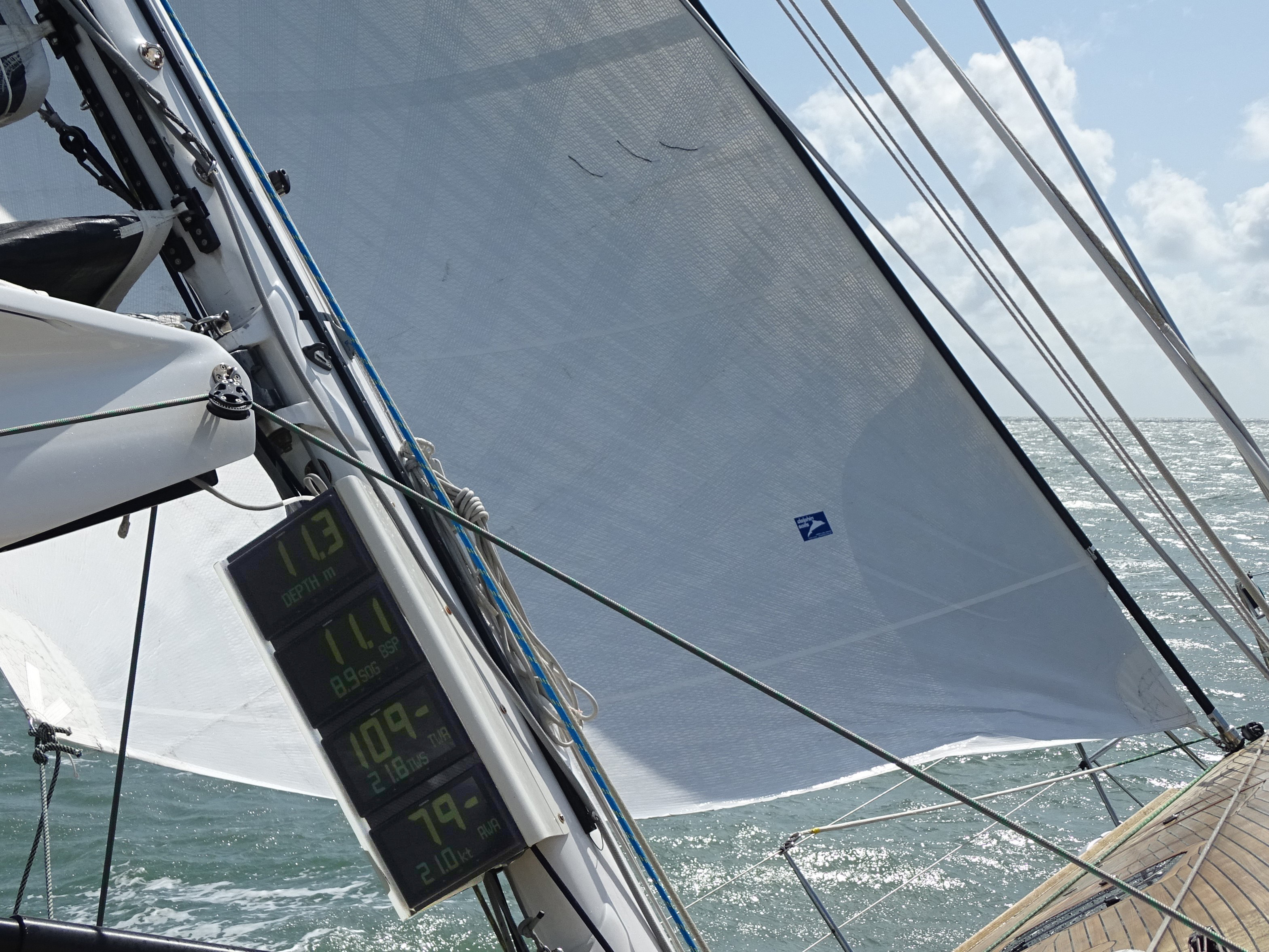
Interestingly Lutine has the German Main sheet system, where the main sheet is led from the port side primary winch. Up to the mast, back along the boom, down to the traveller, back up to the end of the boom, back to the mast and then ends up at the starboard primary winch. This means you can trim the sail from either side, windward or leeward, and this is a brilliant feature if one is in a hurry to trim or dump the main. We used this feature quite a lot!
By mid-afternoon, we decided to return to Cowes and had a leisurely sail back to Shepards Wharf for the night. We had learned a lot about how the boat handled and as the day progressed Paul didn’t need to instruct us so much. Also noticeable was how we all started to gel as a team.
At 18:00 we had the traditional Tot of Rum. This is an old Naval tradition where every crew member was given a daily tot of rum. I think the intention was to stave off scurvy. One thing is for sure – a tot of rum, drunk in one go, does bring a warming feeling to one’s inner being, so to speak. Then off to The Coast for a very pleasant meal.
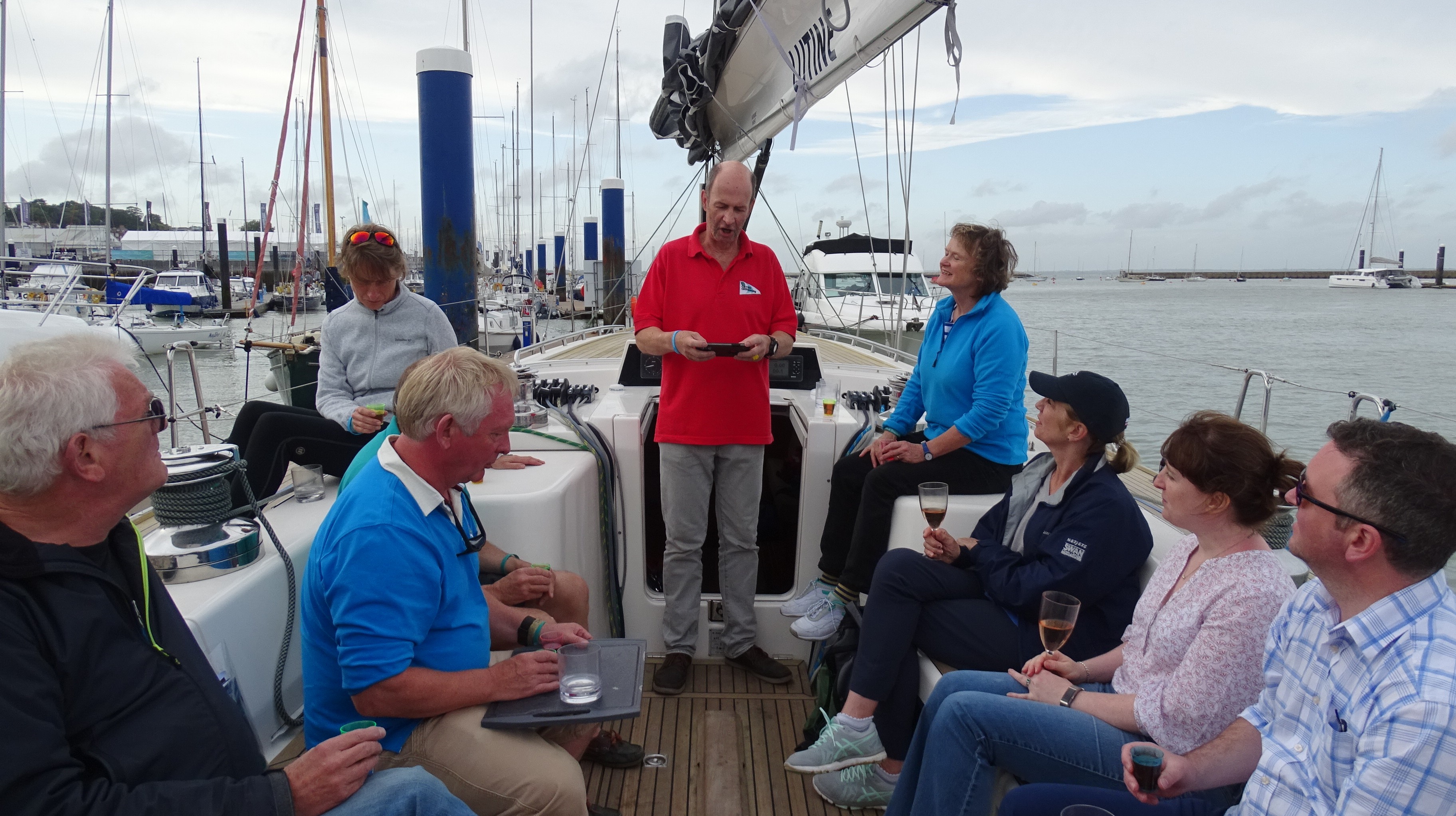
Sunday had been nominated “Nab Tower Challenge Day”, on account of the favourable tides, predicted wind conditions and the fact we would be going from Cowes but returning the boat to Haslar Marina in Gosport.
Demonstrating the efficiency of this master crew, we prepared wraps for our “on the go” lunches whilst a “full monty” fry-up breakfast was being prepared. I have to say that was the first time I’ve made sandwiches with wraps on a boat and I can thoroughly recommend it. You end up with an easily controlled lunch, whereas bread sandwiches can crumble as you try to winch and eat! Top Tip: wholemeal wraps are not ideal for such purposes because they break rather than fold.
With Belinda on the helm we pootled out of Cowes in a very safe and seamanlike manner. And, having checked all the lines and rigging, raised the main and let out the genoa. We were sailing!
The Nab Challenge is one of a series of challenges devised by Lloyds Yacht Club to suit a whole range of weather and tide conditions and crew abilities. Any crew can attempt a challenge during the year, with trophies for the winners at the Club’s Annual Dinner. “The Nab” involves sailing between the forts, out to the Nab Tower, and back again – a round trip of approx 14.5 nm.
With less than ½ mile to go until we reached a transit between Horse Sand Fort and No Man’s Land Fort, we synchronised watches, checked the time on the camera and got ourselves ready for the off. This would be a flying start and we would log our time as we crossed the “line”. At the same time Richard was already logging our track through the GPS system. We had two independent methods for measuring the elapsed time for the challenge. Then we were off, with Richard on the leeward helm.

Let the Challenge commence!
In a way, the journey to and from the forts was uneventful – which is just what one wants when sailing for speed! The wind was gusting 30 knots so the boat became a bit of a handful in the gusts. Speeds were in the 10’s for most of the trip, with the occasional excursion into the 11’s. I saw 11.7, lots of people saw 11.1 to 11.5. Most of the crew climbed to the top of the boat (about 15 feet!) and provided ballast against the efforts of the wind to push us over.

A quick helm change to Peter and then over to Paul, ready for the gybe that we needed to execute once past the Tower. 48 minutes after our start we rounded Nab Tower leaving it to port and 30 seconds later we were beating back towards the forts.

Ready for the gybe around the Nab Tower
A neat gybe managed brilliantly by the team under the mindful watch of Paul meant that we lost very little time. Our minimum speed recorded on the GPS during this manoeuvre was a creditable 6 knots! This team was not mucking about, and 48 minutes put us right in the frame for a new record.
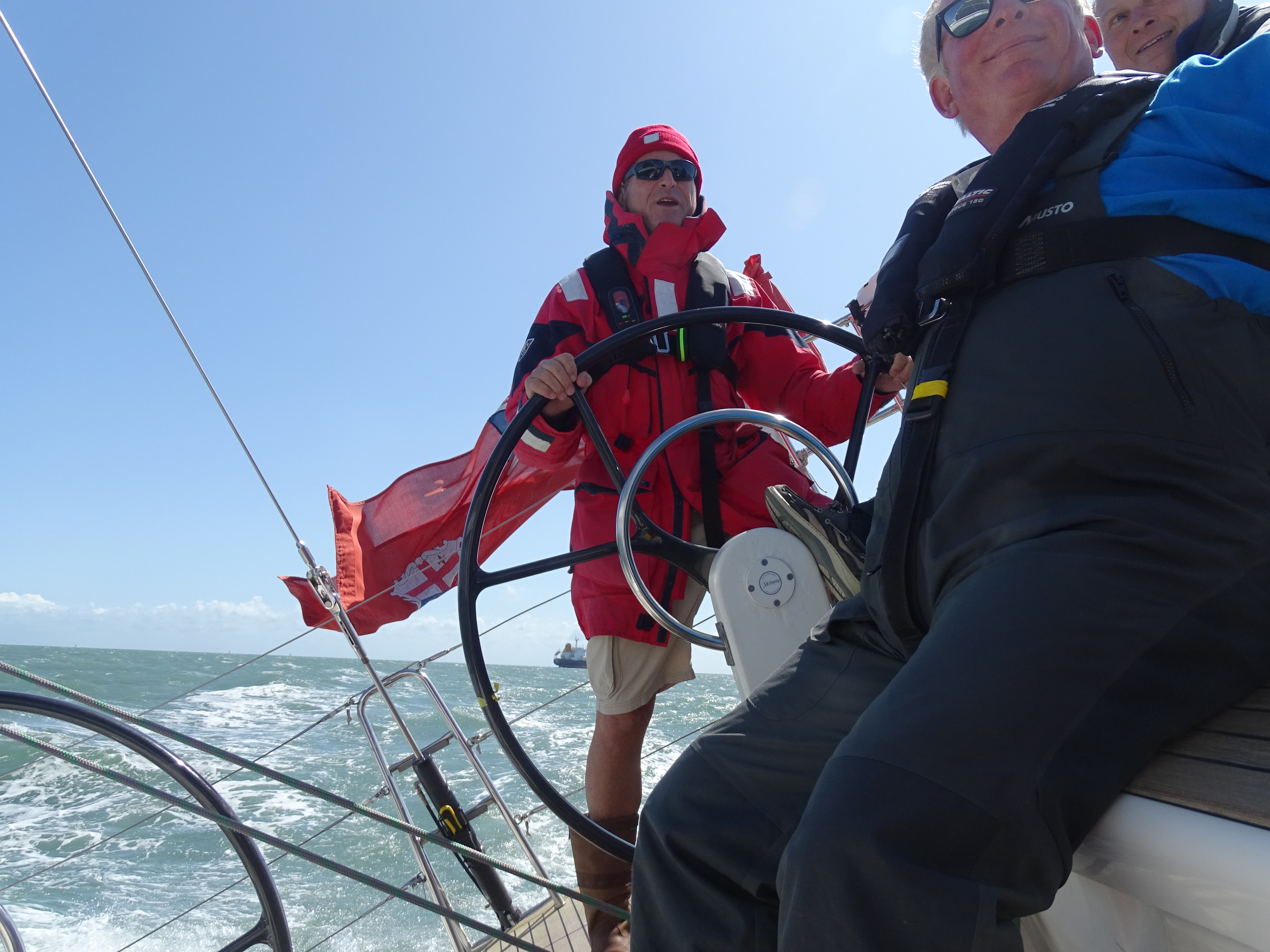
Paul carried on helming back towards the fort because the weather and gusts were by now getting greater. Or so he said, but the broad smile gives away another motive!
Lutine glided through the waves and we were really getting the hang of pre-emptively dropping the traveller as the gusts came in. Suddenly everyone was working as a team. She is such a lovely boat. I want one and have put it on my Christmas List!
James took over the helm and completed the journey back to the Forts. He seemed pretty determined to get a wet bottom, but at least he had a good sightline underneath the sails.
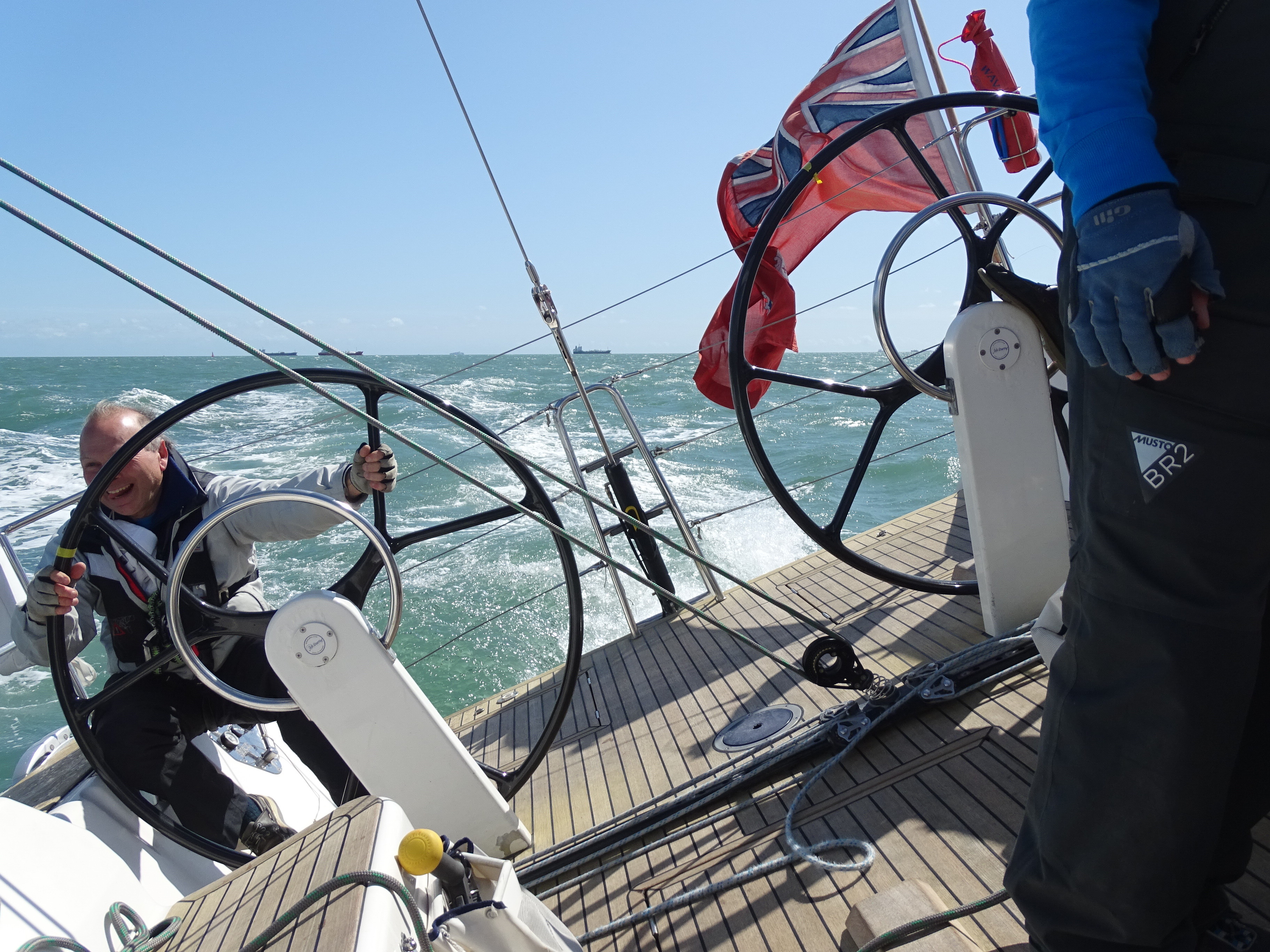
The remainder of the Challenge was made up of avoiding various ships at anchor, a little fishing boat (I bet James he couldn’t get between the man’s rod and the float on the water!) and the various ferries and ships on the move who seemed to have us in their sights. But we scared them off with our demonstration of good sea skills.

We crossed the line in 1 hour 34 minutes and 10 seconds, giving us an average speed of over 9.1 knots. This was a very creditable performance from a crew mostly inexperienced at sailing anything like Lutine. And a credit to Paul for his management of the resources he had available to him.

The table above shows the times and distance for the Challenge. There are slight inaccuracies between the calculated figures from the GPS and the visual method where we had to estimate when we were crossing the transit between the Forts. This is never an easy task.
After 95 minutes of high-adrenalin sailing we opted to slow down for a few minutes and draw breath by getting Lutine to heave-to (backing the genoa and that “fights” with the main and the hull and causes the boat to remain stationary). The problem, I think, was that our main was too large compared to the relatively small genoa, so the boat wanted to sail off rather than stop and in the end she won! But it was a good exercise to try out and we ended up bringing down the Genoa to head up the main channel into Portsmouth.
Ironically enough we had problems keeping the speed below the harbour limit of 10 knots – I think it was 9.7 knots as we entered the harbour. The harbour officer’s launch eyed us up and down as we passed by, just like a motorway speed cop!
We made a quick tour of the main harbour to look at HMS Queen Elizabeth. You have to see the vessel close to in order to appreciate her immense size. Getting her in and out of the harbour entrance is tight and not easy.
Then it was down with the main sail and back to the pontoon in Haslar Marina.
Our lunch in the cockpit was a little subdued, I feel. This was the end of a very memorable weekend. Some of it was exciting, some of it got towards being scarey. Some was wet and some was testing. But it was all enjoyable and that was made possible by Paul who skippered us so well, and us, who made it all happen.
One can tell the atmosphere on a boat instantly. If people are scared they go quiet. If people are cross they show it. The atmosphere on board Lutine was congenial and full of humour. I will never feel the same about being part of a production team making wraps for lunch … the planning department, the procurement department, the production department, the packaging and dispatch department. And lets not forget the sales department! (That was an in-joke amongst The Oxted Octet!).
I couldn’t end this piece without a word about the amazing stewardship of our skipper, Paul May. Being a skipper is not an easy task because you have total responsibility for everyone’s safety and welfare. But a great skipper also wants to help the crew learn, and that takes patience and an ability to stand back whilst people make mistakes. Often it is easier for the skipper or an experienced crew member to jump in and complete the task. But that doesn’t help people learn. Paul was brilliant at balancing the safety requirements with letting people explore their knowledge and make mistakes. He was also very supportive of us all, and for that I will always be appreciative and grateful!
What an amazing weekend. Thank you all!
We have another Oxted Offshore Club Weekend booked on Lutine in October, again with Paul as skipper. Unfortunately this is fully subscribed – we wonder why!! – but hopefully there will be more opportunities next year to experience this fabulous yacht and all it has to offer.
